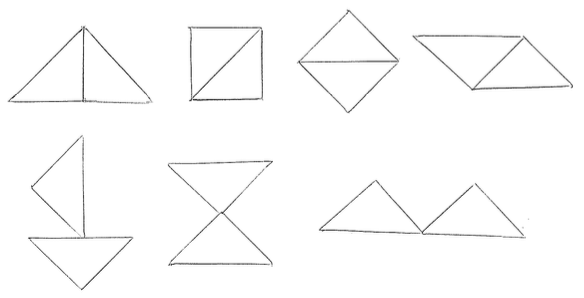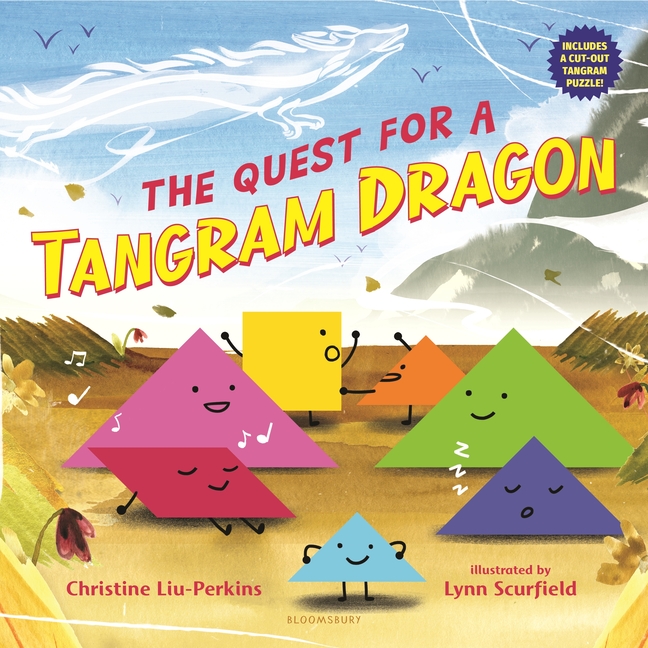Storytelling with Tangrams
When I decided to write a picture book involving tangrams, it had been years since I’d worked with them. I pulled out a set and tried solving sample puzzles. They were challenging! Tricky! Baffling! I had forgotten how to see the multiple ways of rotating and arranging them.
If it was challenging for me, how difficult would it be for beginners first learning about tangrams? Would it be more inviting if they started simple and progressed to more complex? Instead of learning to manipulate all seven pieces right away, how about starting with one piece? Then add one piece and explore what can be created with two pieces. Repeat up to the full set of seven tans. Developing this idea led me to write The Quest for a Tangram Dragon (Bloomsbury, 2024).
I began by playing around with one tan: a small triangle. Somehow I imagined it as being alive—an energetic, fun-loving little character. Sitting on its long side, it looked like a mountain. Sitting on a short side, it looked like a slide. Balancing on its top point, whoops! It fell over.
I added the second small triangle. I arranged the two tans in all the ways I could think of, including a bigger triangle, a square, a diamond, a parallelogram, a sailboat, an hourglass, and side-by-side mountains.

Next, I added the square. What could these three tans form together? Over the next few days, I played around with adding the parallelogram, then the medium triangle, one big triangle, and finally the second big triangle. For each set of tans, I created multiple configurations and traced them onto paper or photographed them.

After building up a library of configurations, I worked on the story. I had two main ideas: 1) the story would start with one tan and build up to seven. 2) At the end of the story, the tans would form a dragon.
I brainstormed ten different storylines. Two seemed the most promising—one with animated tan characters and one with a young girl and her grandmother. I wrote rough drafts of each story and sent them to critique partners for feedback. They liked the version with animated characters more, so I continued developing that storyline.
My first draft of the story was about a little triangle who wants to form a dragon. As new tans join in, they make different configurations—some objects and some animals. At the end, they succeed in making a dragon.
This first draft had a beginning, an ending, and a bit of a plot progression in the middle. I gave this draft the snappy title “1234567.” It had potential, but the ending felt flat and uninspiring.
In a later version, the tans go on a journey to search for a dragon. They join in one by one, forming various objects. When they form a particular animal, they magically turn into that animal, which enables them to continue onto the next part of the journey. At the end, they turn into a dragon.
This version of the story was more interesting because the shapes are on a quest. But something was still missing. There was nothing at stake, no important reason for them to make or find a dragon. Why did they want a dragon? Why did they NEED a dragon?
The answer lay in a power that Chinese dragons are believed to possess: they can bring RAIN! Since ancient times during periods of drought, people in China have prayed to dragons for rain.
Aha! The shapes need to find a dragon because of a drought. Their land is too dry, and the plants need water. A dragon will bring the rain they need.
Now Little Triangle has a purpose for its quest. Like many heroes, it sets out to fill a need and enlists the help of others to work together to fill that need.
In addition, the tans need persistence and teamwork to fulfill their quest. They search and search but can’t find a dragon anywhere. When they can’t reach the top of a mountain, they are ready to give up. But Little Triangle urges them to try one more time. Finally, together they turn into a dragon and shower rain over the thirsty land.
After the story was solid, I added fun language (e.g., “flipped, flopped, and flapped”) and more personality to the individual tans.
Now that you know how I wrote The Quest for a Tangram Dragon, I hope that you and your students will be inspired to invent your own tangrams and create your own stories!
- Step 1: Play with the tans! Take your time to make as many different configurations as you can. Trace or photograph them.
- Step 2: Brainstorm ideas for your story. Choose a storyline to develop.
- Step 3: What configurations could become part of the story you’d like to tell?
- Step 4: Choose a beginning for your story.
- Step 5: Choose an ending for your story.
- Step 6: Decide how the story will get from the beginning to the end. What happens between the beginning and the ending?
- Step 7: Tell your story using your chosen tangram configurations.
- Step 8: If time permits, get feedback and revise your story. What is working well? What needs more development? How can you make the story stronger?

Listen to a Meet-the-Author Recording for The Quest for a Tangram Dragon
Listen to Christine Liu-Perkins talk about her name
Watch a book trailer for The Quest for a Tangram Dragon
Explore Christine Liu-Perkins’s author page on TeachingBooks
Text and images are courtesy of Christine Liu-Perkins and may not be used without express written consent.


Leave a Reply